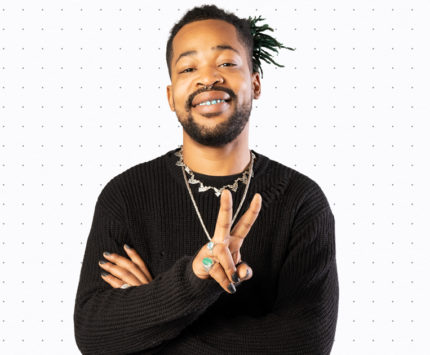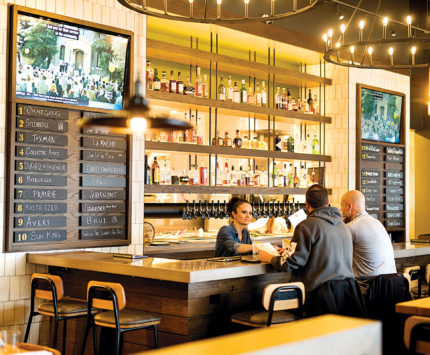
In The Driver’s Seat For ‘People’s 500’ Exhibition
In October 2015, Big Car, in collaboration with artist Jesse Sugarmann and the Indianapolis Motor Speedway, issued the call.
Wanted: 100 Indianapolis residents to pilot an official Camaro pace car for two laps around the famed 2.5-mile oval at the IMS. Together, these 100 participants would complete 500 miles, or the People’s 500.
Sugarmann—whose work, in his own words, “engages the automotive industry as a manufacturer of human identity,” has been shown nationally and internationally and featured in such publications as ArtForum, The Atlantic, The Huffington Post, and The New York Times—would interview, photograph, and film each participant. The output of this effort would be an oral and visual history of the Indianapolis 500, exhibited at Big Car’s new cultural center, the Tube Factory, from May 6 to July 16, 2016.
Needless to say, this piqued my interest.
I quickly discovered that if I wanted to participate, I’d have to fill out a questionnaire. Easy enough. There were the questions you’d expect, like, “Please describe yourself and your interests,” and, perhaps more pertinent, “Do you have a valid driver’s license and a clean driving record?” and “Please describe and explain any driving tickets you have received in the last three years.” (I was relieved to report that I did indeed have a valid driver’s license and had received only one ticket in the last three years, for an illegal U-turn in Canada.)
Then the questionnaire asked about my personal and family history within the city of Indianapolis. (I have lived here most of my life. My parents have lived here, in the same house, since before I was born. My father is an attorney in town, and has been for more than 40 years. My sister, also an attorney, is a regular performer in local theatrical productions. My mother, a PEN Award–winning novelist, is the director of the Indiana Writers Center. Clearly I am the underachiever in this group.)
Finally, the questionnaire asked about my relationship with the Indianapolis Motor Speedway. This was more my speed. I attended my first Indy 500 at age 13, with my dad, in 1985. That was the year of the famous “spin and win,” which happened right in front of us. (For those of you who weren’t born yet, or who just weren’t paying attention, “spin and win” refers to an on-track incident during the race in which Danny Sullivan spun a full 360 degrees—like Linda Blair’s head in The Exorcist!—and still went on to win the race.)
I’ve seen every race since then, almost all of them in person. One year, when I was married to my first husband—who, the one time he attended the race, alienated everyone in our row by bringing sushi—I went to the race by myself because he wasn’t into it. The races I missed in person, I watched on TV. One year, when I lived in Colorado and was too poor to have my own TV, I delayed breaking up with my boyfriend until after the race so I could watch it at his house.
By some miracle, after my first husband and I divorced, I moved in next door to a guy who was an engineer for one of the IndyCar teams. I’m not saying I wouldn’t have fallen in love with him if he had been an accountant, but I’ll admit the racing connection—not to mention his cooking skills and accent (he’s French)—added to his appeal. These days, he’s the chief engineer on the KVSH Racing Technology number-11 car, piloted by Sebastien Bourdais. We’re pretty immersed in the IndyCar world, and I’m a little embarrassed by how much I love it.
These answers, it turned out, were good enough for Sugarmann—which was how I found myself at the Indianapolis Motor Speedway, clad in a black fire suit (this seemed like overkill, but whatever), on a crisp and cloudless October Friday. Sugarmann interviewed me—I told the story about my ex-husband and the sushi—and his crew snapped my photo. Then I slid into the driver’s seat of a white Camaro pace car, bedecked in yellow and black decals, and buckled up.
In front of me was the Chevy truck that would serve as my pace car. The driver of the truck had instructed me to maintain a speed of 30 mph. This, frankly seemed a travesty, and I said as much. “Okay,” he replied conspiratorially. “Just drop back a bit and gun it to catch up.”
So I did. As we navigated through turn one and the short chute, I let the distance between us unspool. Then I floored it through turn two—those Camaros are fast—lifting only when the truck’s rear bumper drew dangerously close. I took it easy through turns three and four. Workmen were replacing the fence there, one of the many improvements being made to the track in the run-up to the 100th Running of the Indy 500, and it seemed ill-mannered to run them over. I picked it back up down the main straight and across the yard of bricks. Then I did it all again, one more time.
I’ve spent a lot of time at—and on—the track. I’ve run (staggered?) around it multiple times, during the Mini Marathon. I’ve ridden around it on a golf cart, driven by one IndyCar driver, and in the back of an IndyCar two-seater, driven by another. I’ve even hit the back stretch, briefly, on a motorcycle. But until last October, I had never had the opportunity to drive all the way around it myself—let alone in a bitchin’ Camaro. Big Car Collaborative, Sugarmann, and the IMS gave me—and 99 other race fans—that chance, and I’m grateful.
The People’s 500 is a collaboration between Big Car, artist Jesse Sugarmann, and the Indianapolis Motor Speedway. The exhibit, curated by Shauta Marsh, was funded by the Andy Warhol Foundation for the Visual Arts and by Creative Capital. It will be on display at the Tube Factory, on the city’s near-south side, from May 6 to July 16. For information about the upcoming First Friday event, click here.





